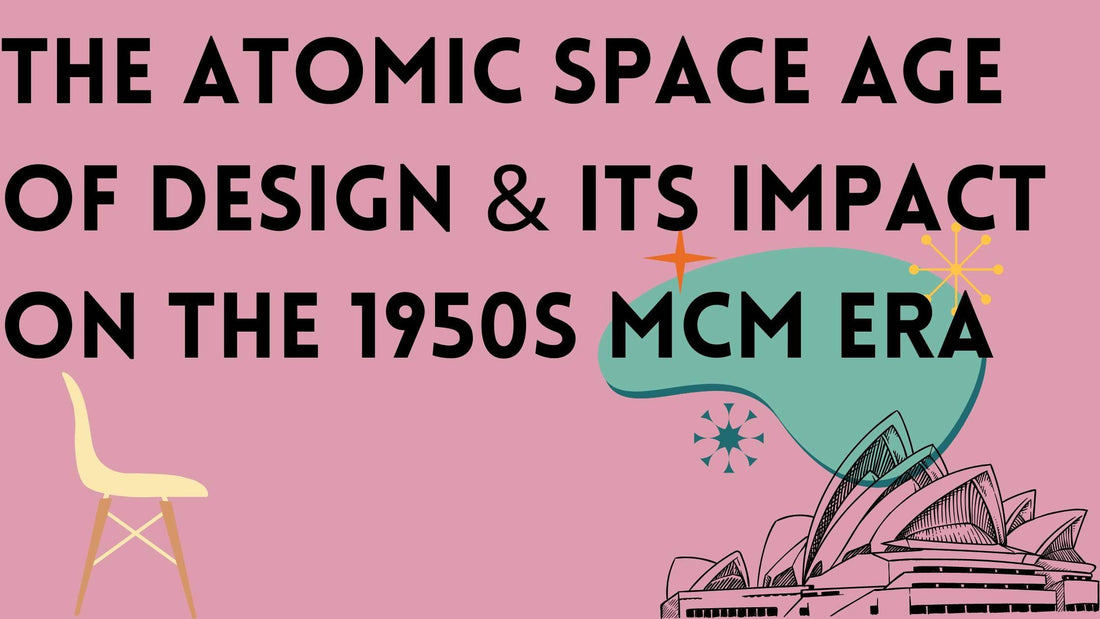
The Atomic Space Age of Design: How It Impacted The 1950s MCM Era
Share
The 1950s was a decade of great change, both in terms of technology and design. During this post-war period, with the dawn of the atomic age and the space race, the world was looking towards the future with a sense of optimism and excitement!
This sense of progress and innovation was reflected in the design of the time, but exactly what impact did the atomic space age of design have on the look and feel of the decade?
New Materials and Technologies
One of the most significant ways that the atomic space age of design impacted the 1950s was through its use of new materials and technologies. With the advent of new materials such as plastics, designers were able to create new forms and shapes that were previously impossible. This allowed them to create designs that were futuristic and otherworldly, which was perfect for the atomic age.
Focus on Functionality
Another important aspect of the atomic space age of design was its focus on functionality. With the world changing rapidly, designers wanted to create products that were not only beautiful, but also practical and easy to use. This was reflected in the design of everyday items such as furniture and appliances, which were streamlined and functional, rather than ornate and decorative.

{Red molded plastic seats; made with new technology, but still focused on functionality}
Color
The atomic space age of design also had a big impact on the way people thought about color. During the 1950s, designers began to experiment with new ways of using color, such as bold, bright, and contrasting hues. This was in stark contrast to the more subdued and muted colors of the past, and it reflected the sense of optimism and progress that was associated with the atomic age.

{Examples of Bold Colors}
Perhaps one of the most iconic examples of the atomic space age of design is the Eames Lounge Chair. Designed by Charles and Ray Eames, this chair was created using the latest materials and technologies, and it was designed to be both functional and beautiful. The chair's sleek, modern lines and use of contrasting colors made it the perfect embodiment of the atomic space age of design.
Architecture
The atomic space age of design also had a big impact on architecture during the 1950s. Architects began to experiment with new forms and shapes, and they used new materials and technologies to create buildings that were futuristic and otherworldly. One of the most famous examples of this is the Sydney Opera House, which was designed by Jørn Utzon and opened in 1973, but it was designed during the 1950s. Its iconic curved roof, which was inspired by the shells of sea creatures, is a perfect example of the atomic space age of design.

{Sydney Opera House}
In conclusion, the atomic space age of design had a profound impact on the 1950s. With the world looking towards the future, designers, architects and other creative people began to experiment with new materials, technologies, and forms, which resulted in a new look and feel for the decade. From furniture to architecture, the atomic space age of design left a lasting impact on the world of design, and it continues to be an inspiration for designers today. It's a reminder that design can be both beautiful and practical, and it can have a significant impact on the way we live and view the world around us.
Click through to see some modern interpretation of space age designs and motifs below! Be sure to bookmark our site and visit often as we will have a blog post about these design motifs in the near future! ✨
✨Retro 50's Space Age Tripod Tabletop Lamp
{Available @ lovevisionkarma.com}
✨Atomic Starburst Window Curtains
{Available @ lovevisionkarma.com}
✨Retro 50's Atomic Space Age Table Runner
{Available @ lovevisionkarma.com}



